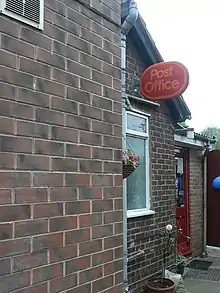Bole, Nottinghamshire
Bole is a village and civil parish in the Bassetlaw district of Nottinghamshire, England. It is close by the River Trent, on the eastern side of which is Gainsborough in Lincolnshire. At one time the village stood – like the neighbouring parish of West Burton – very near to an oxbow lake, known as Bole Round. However flooding led to the original course of the River Trent being diverted after 1792. The parish now lies within a landscape largely dominated by the West Burton power stations. According to the 2001 census Bole had a population of 140,[1] increasing to 247 at the 2011 Census.[2]
| Bole | |
|---|---|
 St Martin's Church, Bole | |
 Bole Location within Nottinghamshire | |
| Population | 247 (2011 Census) |
| District | |
| Shire county | |
| Region | |
| Country | England |
| Sovereign state | United Kingdom |
| Post town | RETFORD |
| Postcode district | DN22 |
| Police | Nottinghamshire |
| Fire | Nottinghamshire |
| Ambulance | East Midlands |
| UK Parliament | |
History

The parish church of St Martin was extensively rebuilt in 1865–66 by Ewan Christian.[3] In former times the village also had shops, public houses and a post office.
The original church was mentioned in the Domesday survey of 1086. From an early date the vicarage was in the patronage of the prebendary of Bole, being until 1841 part of the Peculiar jurisdiction of the Dean and chapter of York.[4] During the early 19th century the manor of Bole or Bolum was held by Lord Wenlock.[5] However, in 1858 the Bole estate was transferred to the use of Lord Middleton, head of the Willoughby family from Wollaton Hall.[6]
The old National school was built in 1859[7] but closed during the early 1950s. It now serves as the village hall. A small Wesleyan chapel was also closed during the early 1960s, being sold and converted for residential use.
There was a windmill close to the Gainsborough road (grid reference SK789864). Manor Farm, a listed building next to Bole Church, includes earlier portions dating from c1675.[8]
A former teenage resident of the village was Henrietta Stockdale, later to become distinguished as a pioneer of nursing and nursing registration in South Africa. Her father became vicar of the parish in 1858, establishing the parochial school and also building the old vicarage (now known as Bole House), where the family was finally able to move in 1864. Bole had previously not had a resident priest for more than two hundred years.[9]
References
- Nottinghamshire County Council 2001 census: Parish Profiles, retrieved 27 June 2013
- "Civil Parish population 2011". Neighbourhood Statistics. Office for National Statistics. Retrieved 6 April 2016.
- Pevsner, Nikolaus. 1970. The Buildings of England: Nottinghamshire; revised by E. Williamson. Harmondsworth, Middx. Penguin, p. 80. There is also related correspondence in Nottingham University Library, ref. Mi E 33/3/2
- K S S Train, Lists of the Clergy of North Nottinghamshire, Thoroton Society, 1959–60, page 18
- White's Directory of Nottinghamshire, 1853
- Access to Archives: Conveyance of the Bole estate and manor of North Wheatley, Nottinghamshire, to the uses of the will of Digby, Lord Middleton, 14 April 1858 Mi 3G 91/1/9 1923
- Nottinghamshire Archives online catalogue, retrieved 27 June 2013. The county archives holds surviving school log books from 1863–1907
- British Listed Buildings, Bole Manor House, retrieved 27 June 2013
- Sister Henrietta, Community of St. Michael and All Angels (edited by Dowager Lady Loch and Miss Stockdale). London: Longmans, 1914.
External links
![]() Media related to Bole at Wikimedia Commons
Media related to Bole at Wikimedia Commons